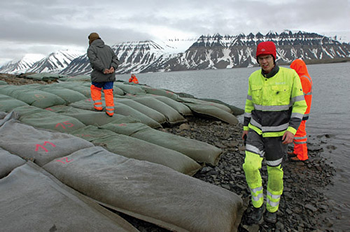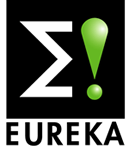 Synthetic bags filled with sand was the solution that French and Norwegian partners came up with when they cooperated on a project to find new environment-friendly building materials that can withstand ice erosion and corrosion.
Synthetic bags filled with sand was the solution that French and Norwegian partners came up with when they cooperated on a project to find new environment-friendly building materials that can withstand ice erosion and corrosion.
The bags will be used as building blocks to protect roads and infrastructure in Arctic areas. The main Norwegian partner in the recently concluded three-year project was the independent research organisation SINTEF. The project was initiated by its French partner, the company TenCate Geosynthetics France S.A.S.
Simple and Natural
“It is particularly difficult to find good building and construction materials in Arctic regions. Local natural materials are often of poor quality, or have to be transported over long distances, which can mean high financial and environmental costs,” says Arnstein Watn, Research Director, SINTEF Building and Infrastructure.
There are no large rocks in the Arctic, but sand, small stones and soil are readily available. “The aim of the project was to develop a solution that could exploit the availability of these local materials,” adds Watn.
Special materials for Arctic regions
TenCate Geosynthetics France has been pioneering developments in geosynthetic materials for 30 years. The term geosynthetic means that a synthetic material is used together with soil.
Bags made of the materials specially designed by the company for Arctic regions were used in the project in Svalbard. SINTEF provided expertise throughout the whole project and participated in the testing of the bags that took place in Svea on the site operated by Store Norske Spitsbergen Grubekompani (SNSK). Much of the field work was carried out by doctoral student Fabrice Calline from the University Centre in Svalbard (UNIS)/Norwegian University of Science and Technology (NTNU).
The project received funding from the European innovation network EUREKA and the French-Norwegian Foundation.
Exciting results
 |
The bags have been in use in Svea since they were installed in 2006.
“The first winter was harsh, with huge stresses caused by ice erosion. We were not at all sure that the bags would withstand the strain, but when the ice melted in the spring, we were very pleased to see that only a few bags had been damaged,” explains Watn.
The damaged bags were replaced and even though the next winter also put enormous strain on the materials, the construction worked well. The project’s final report is extremely positive. Now the partners want to study other ways of exploiting this technique.
High Market Potential
“SINTEF is very keen to be involved in developing products that have a positive environmental impact. The partnership has worked extremely well and we have benefited greatly from the funding we have received through EUREKA and the French-Norwegian Foundation,” says Watn.
TenCate has patented the geosynthetic bags and is responsible for production. The company believes that the product has high market potential. According to U.S. Geological Survey 25 per cent of the world’s undiscovered oil and gas resources are located in the Arctic. More oil fields are already planned, and there is a great need for local construction materials.
ABOUT EUREKA
 EUREKA is a European network for innovation that aims to enhance European competitiveness by promoting market-oriented R&D. All EUREKA projects must have partners from at least two of the currently 36 member countries. The projects are carried out jointly by companies and research institutions, with the companies playing a leading role.
EUREKA is a European network for innovation that aims to enhance European competitiveness by promoting market-oriented R&D. All EUREKA projects must have partners from at least two of the currently 36 member countries. The projects are carried out jointly by companies and research institutions, with the companies playing a leading role.
Norwegian companies and research institutions are currently participating in 34 EUREKA projects. To date, Norwegians have participated in 220 projects.
Read more about EUREKA
Read more about the Norwegian participation in EUREKA (in Norwegian)
ABOUT FRENCH-NORWEGIAN FOUNDATION
The French-Norwegian Foundation promotes long-lasting French-Norwegian cooperation through the financing of joint R&D projects in which both industry and research are involved. The Foundation also provides support for workshops and seminars with participants from the two countries. Read more about the French-Norwegian Foundation.
This article was published originally in Norwegian by Faktotum AS. It was adapted by Else Lie at the Research Council of Norway for an international, English-language audience. Additional translation support was provided by Anna Godson and Carol B. Eckmann. The article and the photographs within it have been reprinted here with permission.
RELATED LINKS
Eco-friendly Defence Against Erosion in Arctic Regions – October 2009
TenCate Geosynthetics Profile on Geosynthetica
SINTEF Home Page











